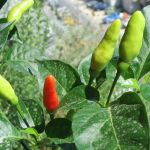| Common Name: |
Hot Pepper |
| Other Names: |
Tabasco pepper, spur pepper. |
| Botanical Name: |
Capsicum frutescens syn. C. minimum |
| Genus: |
Capsicum |
| Family: |
Solanaceae |
| Location: |
Tropical America |
| Cultivation: |
Rich, well-drained soil in sun. Capsicum baccatum var. pendulum and C. pubescens withstand cooler conditions. Capsicum pubescens may be espaliered or pruned. Plant bugs may damage growing points and leaves; plants under cover may be affected by spider mite, whitefly, and aphid. |
| Propagation: |
By seed sown in early spring. |
| Harvest: |
Unripe fruits are picked as required and used raw, pickled, or cooked. Ripe fruits are picked in summer and used fresh, pickled, or dried for condiments, decoctions, ointments, powders, tinctures, tablets and oleo-resin. |
| Height: |
45cm-1.5m (1½-5ft) |
| Width: |
60cm (24in) |
| Variations: |
Tabasco
Has very pungent, erect, yellow to yellow=green fruits, 2.5-5cm (1-2in) long and 0.5cm (¼in) wide, that ripen red. Used in creole cooking and for tabasco sauce.
Height: 60-90cm (2-3ft)
Width: 60cm (24in) |
| Hardiness: |
Min. 4-21°C (39-70°F) depending on cultivar. |
| Parts Used: |
Fruits |
| Properties: |
As for pungent-fruited cultivars of C. annuum. |
| Medicinal Uses: |
As for pungent-fruited cultivars of C. annuum. |
| Culinary Uses: |
As for pungent-fruited cultivars of C. annuum. |
| Warning: |
Capsicum oleo-resin is subject to legal restrictions in some countries. |
| Bibliography: |
Encylopedia of Herbs by Deni Brown Copyright ©: 1995, 2001 Dorling Kindersley Limited pp 153-154, 155
|
